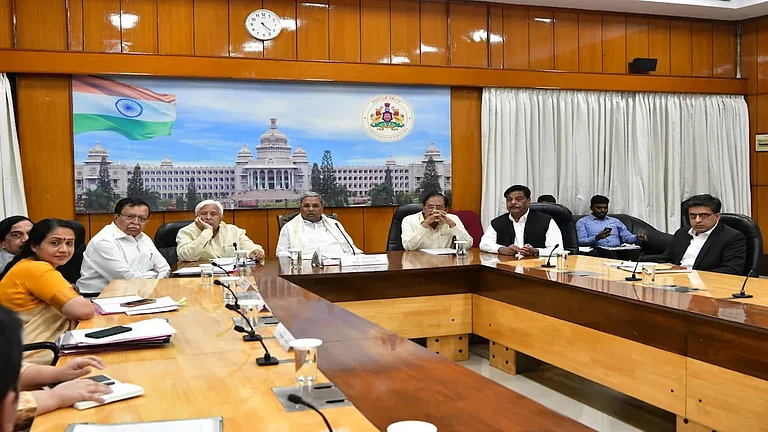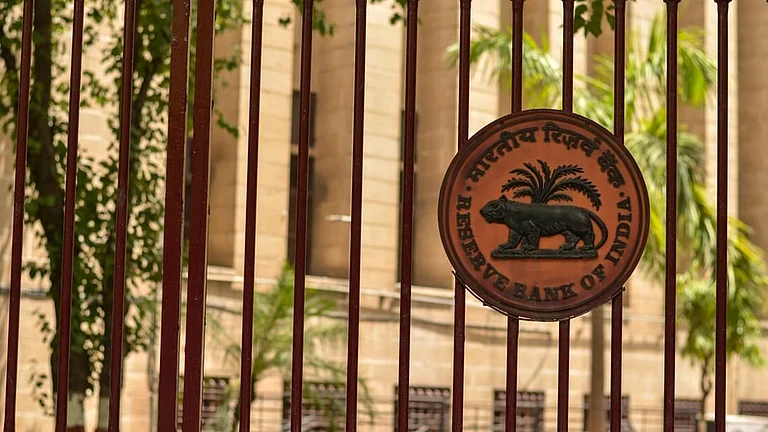Oculus was one of the many 3D device companies in the virtual gaming world till 2014. It had a promising device in Oculus Rift, which gamers loved and the gaming community thought would change its world. However, Oculus as a whole did not seem to have a great advantage over any of its competitors in terms of technology innovation or market share. It did not imagine a pathbreaking future. When Facebook acquired it that year for $2 billion, observers wondered how a hardware manufacturer fitted into the vision of a social media giant, whose mainstay was digital advertisements.
Cut to October 2021. Facebook, a company which corners a lion’s share of digital advertisements in the geographies it dominates, made an announcement which, on the face of it, looks like a rebranding and repositioning exercise at an unprecedented scale for a tech company. On October 28, 2021, its CEO Mark Zuckerberg announced that Facebook, the company, would henceforth be called Meta Platforms, a rather obvious take-off from metaverse. He outlined a new vision: “We believe the metaverse will be the successor of the mobile internet. We’ll be able to feel present – like we’re right there with people no matter how far apart we actually are.”
He added that he expected a billion users to access metaverse in the next 10 years. Such is the importance the company leadership attaches to the proposed virtual reality business that it has decided to create a separate head for Reality Labs in its account books, where it proposes to declare its revenue and profit results.
As the transition of Facebook into Meta unfolds, it is undergoing a shift in its business approach, which is simultaneously a radical shift from the existing social media business as well as an incremental addition to the existing revenue strategy, as of now. The latter component is likely to be more pronounced in India, where, in its Facebook avatar, the company has already built a large community of individual and small business users, developers, business partners and government departments.
The India Avatar
In 2018, something changed for Facebook in India. The company changed its leadership structure, first, to expand its team and, then, to create a direct line of communication between the India office and the San Francisco office. The company says that these changes were a recognition of the importance of India in its overall strategy. Its numbers have steadily increased in India. At the last count, 435 million people accessed Facebook every month, with 272 million logging in every day.
Meta India’s vice president and managing director Ajit Mohan begins his over-an-hour-long interaction with Outlook Business by highlighting what he calls the “compelling India story”.
India’s internet users, who grew from about 340 million in 2016, before the advent of Mukesh Ambani’s Jio, to over 820 million in 2021, might fall short of China’s claims of a billion users and counting, but it is this exponential rise which makes India a “compelling story” for Meta. Add to it the Facebook and WhatsApp’s user base and it explains Meta’s over billion dollar revenue from the subcontinent last year.

Top L to R: Rajiv Aggarwal, director and head of public policy, India; Abhijit Bose, head of India, WhatsApp; Rishi Raj Gupta, director HR, India, Bipasha Chakrabarti, director, communications, India; Sandeep Bhushan, director and head of global marketing solutions, India
Sitting L to R: Sreene Ranganathan, director, strategy and operations, India; Ajit Mohan, VP & MD, India; Avinash Pant, director, marketing, India; Manish Chopra, director and head of partnerships, India (sitting on the chair)
The pandemic exacerbated this much-talked-about “digital shift” rewritting the paradigms of communication and consumer engagement, prodding Meta to treat India as a canvas for experimentation. Be it Instagram Reels or payments on WhatsApp, Mohan explains how “deeply Meta is investing in India”, where the developer community will play a pivotal role for the company in its journey to define metaverse in the next decade. But central to Meta’s India story is the growth of the country’s 66.3 lakh small and medium businesses (SMBs).
“We are clear that we want to play an enabling role for these businesses. If you look at our revenue growth in the past three years, it is driven by small businesses. Globally, there are 200 million businesses on our platform. Only 10 million are advertisers. The remaining are on our platform because they see value, but whose relationship with us is not yet commercial but has an economic impact. This is an important part of our model,” explains Mohan.
In India, nearly half of operational SMBs using Facebook reported making at least a quarter of their sales digitally, reports Meta’s State of SMB Survey report, dated March 2022. The report further states that in India, there are more than 15 million monthly active users on the WhatsApp Business app; it is data such as this that makes India a sweet spot for Meta, keeping it at the centre of its transformation.
Whether it is Instagram, which is becoming the new melting pot of discovering and scaling businesses, Meta’s initiative to facilitate loans to SMBs, its partnership with Jio or even the focus on skilling; it is clear that for Meta, the next avenue for growth in India will depend on its success in bringing the vast ecosystem of SMBs on the digital highway. Meta’s metaverse will be called to action for this purpose but the path is yet to be defined, explaining why Mohan holds back giving us deeper details.

Meta seems to be going slow with its AR and VR plans in India but is not losing sight of the future. As a reflection of its strategy, through which the metaverse business model will be built on an existing and successful social media model, Meta opened its largest office in India in Gurugram on the outskirts of Delhi in December. The plush 420-seat, 1,30,000-square-foot office houses Facebook, WhatsApp and Instagram teams to supplement a new division called the Centre for Fuelling India’s New Economy, or C-FINE. Here, in an old-world-meets-new-world real space, a visitor can feel virtual spaces through Horizon Worlds and Horizon Workrooms apps loaded on to the Quest 2 devices.
Mohan speaks eloquently about digitally empowering India’s small businesses and supporting its creator economy through C-FINE. At the same time, he reminds us, in his boss Zuckerberg’s language, that his company will change the way the world perceives virtual reality and build an entire economic ecosystem around it, which will develop its firm contours in the next decade. He says, “As a company, we can play a helpful role in shaping metaverse over the next 10 years … In the long evolution of technology, from print to radio to television to mobile, there is no way to look at this as anything but a big-step change in the evolution of the internet.”
Unlike Zuckerberg, Mohan is not forthcoming about the investments made in the Reality Labs component in India, but he says that the metaverse in India, whatever shape it takes, will be multilingual and “Indian” the way Facebook is. He says, “You cannot be relevant in all of India if you are only in a language or two. If you look at Reels, it is happening across the country. It is happening in Bengali, Bhojpuri, Malayalam and Marathi. Anything that has hundreds of millions of users in India will have the diversity of India show up. That is true in the 2D version of the internet. It will be true in the 3D version of the internet.” Manish Chopra, director and head of partnerships at Meta, agrees with Mohan. He says, “Seventy per cent of videos on FB Watch are in Indian languages.”
Chopra says that Indian creators are at the forefront in using tools like Spark AR. He says, “We have seen a lot of Indian creators start publishing a lot of AR effects or filters.” Realising that AR and VR adoption needs to be pushed actively, Meta engages the target audience through creator immersion programmes. Then, it all comes together in the form of creating revenue and value for creators. “We have been giving millions of dollars ad revenue share to creators. Video creators have been making money by making content in which we do ad revenue share. But, today, reels creators make money in multiple fashions. They make money because they endorse brands, and we have a brand collaboration approach with them. We are the platform where their authenticity helps them do campaigns with brands,” Chopra says.
Meta sees enough opportunity for its social media and messaging apps in India for it to keep investing in their further development. WhatsApp, for example, is using a two-pronged strategy to win users and create a revenue model. On the one hand, as stated above, it has garnered more than 15 million users for its business app, and, on the other, it is selling an API to service providers, like financial institutions, which create a channel of communication with their users
on WhatsApp.
The API route answers critics who have been claiming that Facebook’s WhatsApp acquisition was carried out without a sound business plan in mind, since the biggest of banks in India are now using a paid WhatsApp API to connect with their customers. Meta claims that small businesses in India have uploaded around one million product catalogues on WhatsApp Business, through which they raise direct orders from customers. Add to it WhatsApp Payments, which brings the UPI payment option within a chat window, and you have a deadly combination to succeed in India, which is addicted to Meta products.
Sandeep Bhushan, lead, Meta for business in India, says, “I think that each of our platforms is fundamentally built to aid small businesses. For example, the smallest business on WhatsApp talks one-on-one with the community it already has. It is either taking grocery orders for you or sending you reminders to pay your insurance premium.
“There are many brands on Instagram today that were born there. … The size of the brand does not matter. The smallest of the brands have been born because it does not need to go wider than Instagram.”
Meta’s stated goal is to enable 10 million small businesses and entrepreneurs for digital economy through C-FINE in three years. If these numbers materialise, the revenue potential for Meta’s legacy products in India will be significant, even if its old advertisement-driven revenue model
stagnates globally.
As Mohan puts it: “In India, it is not a choice of ‘this’ or ‘that’.” It a combination of the old Facebook and the new Meta.
Meta’s Own Universe
The importance of rebranding is not difficult to see. Sascha Kraus, a management professor at the Free University of Bozen-Bolzano in Italy who studies digital transformations, says, “What Zuckerberg promises is nothing less than a revolution. The change of name makes sense, since the parent company was no longer just Facebook itself. Of course, the change of name came exactly at a time when the wind was blowing increasingly rough for Facebook.” Kraus made this statement in the context of various controversies that hit Facebook globally.
In the fast-changing internet economy, it is reinvent or perish even for mega companies. Keeping with the hectic pace of internet evolution and changing consumer behaviour, tech companies have found the need to reinvent themselves once every decade. The ones which do not do so end up as ping pong ball between suitors, as the Elon Musk’s blow-hot-blow-cold affair with Twitter suggests. The microblogging website was known for setting political agendas in most countries it operated in. Politicians, policymakers, celebrities, journalists, all announced their points of view on Twitter, but apart from raising the character limit of each tweet from 140 characters to 280, it is not known to have changed with the times.
Notably, Microsoft made a decisive move away from personal computing and manufacturing mobile devices to offering cloud services under CEO Satya Nadella. Google kept moving from one model to another with search engine, email, Android, cloud services, etc. as important milestones. Each major tech company begins to think of reinvention when growth plateaus in its core business activity.

Social media companies are not seen as traditional tech service providers. Consumers associate the value of a single brand with them, thus making reinvention difficult. Twitter seems to be suffering on this count, while Facebook has taken a leaf out of the book of Big Tech to refashion itself.
Sujit Kumar, former MD of Sony Pictures Entertainment and visiting professor at IIM Ahmedabad, says, “While the timing—coming under attack from regulators—made it appear as a rebranding exercise in late October 2021, recent performance data suggests that it is to counter the dip in revenue and declare Zuckerberg’s intent to make himself relevant to the younger demographics by positioning himself as a frontrunner in the evolving metaverse economy.”
In a first, the company opened a brick-and-mortar store in California, US, called the Meta Store, in early May. The seriousness with which Meta is pursuing the hardware part of its metaverse strategy shows that if it has to make metaverse a commercial success, it must show to the world what immersive devices can achieve for a metaverse economy. Scott Stein, editor at large at CNET, who tracks developments in the VR space, feels that through Oculus devices, Meta has already shown that it is beyond competition due to multiple reasons. He says, “Oculus Quest 2 is way ahead of competitors on two fronts: price and software features/content. The price factor is something Meta gets to in a way others cannot compete on at the moment. But software could be where others catch up, as well as hardware.”

Meta, of course, is not the first digital company that has found investment in hardware devices useful. Google with Nexus and Pixel phones and Chromebook, Microsoft with Surface laptops and Amazon with Kindle devices have found hardware integral to their business and branding strategies. However, none of them lives off hardware earnings. Amazon’s Jeff Bezos once said that Kindle devices are sold at cost.
Just as these digital majors have negligible revenue from the sale of hardware devices, their investments in this area are also a miniscule percentage of their overall spend. However, Meta’s investment in Oculus and other devices is a scale apart. While declaring the December quarter results, Meta said that it spent a staggering $10 billion in 2021 in Reality Labs. Compared to its earlier version as the Oculus division, Reality Labs generated better revenue in Q1 of 2022 at $695 million, up from $534 million a year ago. However, the Q1 loss of 2022 was also higher at $2.96 billion, up from $1.83 billion a year ago.
The grand figures of both investment and losses are Zuckerberg’s way of telling investors and markets that his virtual reality business is like no other that he or anyone else has attempted in this space. The jury, however, is out on whether Meta sees investments in VR and enriched video devices, like the Portal series, as potential revenue streams or if they are just preparing users and developers for the vast opportunities that metaverse will throw up.
For India, however, both hold promise.
With one of the largest developer communities in the world, Meta’s metaverse holds immense opportunities for India. In fact, realising this potential, Meta India is already collaborating with the Central Board of Secondary Education with the purported aim to train one million teachers and 10 million students in technologies that can help the latter become developers in a metaverse economy.

And for the grand investments that are reflected in Meta’s books, a pie of it is already flowing into India as it trains SMBs and creators to combine metaverse for higher profits.
“That is not coming with any transactional goal of revenue growth. It is purely saying, how do we fuel the agenda of skilling and the two parts where we can play a role that is businesses and creators, because we see that when they are enabled, the multiplier effect on the economy is massive,” says Mohan. With bets on metaverse increasing exponentially, it is likely that Meta’s skilling spend will create value for SMBs which can then leverage the tech giant’s large user base in India.
Meta’s Platforms
Meta has largely been a three-app company. Facebook, Instagram and WhatsApp have allowed it to dominate the social media and personal messaging space, with the first two helping with the digital advertisement market. The most important tweak that Facebook’s transition into Meta introduces is likely to be in the way Meta earns its revenue.
So far, Meta has an acute dependence on advertising revenue. In 2020, it earned over $84 billion in revenue from advertisements, which was about 97% of its total revenue. Its advertisement revenue went up to $114.9 billion in 2021, a 23.5% increase over the previous year. Despite the growth, observers see reasons to worry in this model as its monthly active users are stagnating, which is particularly true of Facebook. In Q4 of 2021, Facebook’s monthly active users remained stagnant at 2.91 billion from Q3 2021. Multiple reports and leaks from the company sources have claimed that Meta is also worried about the old social media-driven revenue model continuing to be relevant for long. These factors together explain the aggressive push Meta is making in metaverse.
Even as Meta makes announcements about sharing revenue with creators in the older social media model, things are likely to be different in metaverse. Meta seems to be moving in the direction of a full-scale platform and aggregator revenue model, where, on the one hand, its platforms aggregate virtual reality games, apps and services, and, on the other, create platform technology on which service providers could mount their own services with their unique business models.

Kraus feels that there are countless ways in which revenue can be earned in metaverse. He says, “Meta is currently experimenting with a virtual open world called Horizon Worlds, in which it is trying out the monetisation of the virtual world. So-called creators will be able to offer their products and effects, such as access to VIP areas or special items in metaverse, in which Meta itself will always have a percentage share.”
Even though Meta relies on advertisement revenue, it is not a complete stranger to the platform-based business model. It already has a successful app aggregation platform in Facebook App Center, which was meant to be a hub for different types of third-party apps. However, now it is dominated by instant games. Meta claims that more than 350 million people played games on Facebook every month in Q3 2020.
Meta has already taken a clear step to redefine its platform model through the Oculus store. In fact, the transition is nowhere more apparent than on the Oculus website. A conscious rebranding exercise is underway, with the parent Oculus domain oculus.com being redirected to a newly launched store.facebook.com/quest, where the erstwhile Oculus Quest is positioned as Meta Quest.
Experts believe that in the metaverse economy, Meta cannot bank on a piecemeal platform model, like the Facebook App Center, since metaverse users and developers are likely to accomplish complicated tasks in this space, which needs to have a robust infrastructure underneath it. In this sense, Meta’s metaverse is likely to follow the cloud model of Big Tech players, like Microsoft, IBM, Google, Amazon, etc., where Meta is an all-encompassing intermediary on whose tech infra companies, governments and individuals build micro-economies of scale.
While many VR apps on the Oculus store have started making serious money—Chris Pruett, Meta’s director of content ecosystem, claimed in February that “over $1 billion has been spent on games and apps in the Quest store”—the gulf between mobile app ecosystem and Meta’s VR store is wide. While Meta takes time to launch the Oculus devices in India, it cannot ignore the fact that the abundant mobile ecosystem, particularly on the Android OS, has a large number of India-centric success stories, including Meta’s WhatsApp. The successful transformation of Facebook into Meta will be the journey on the bridge between the two ecosystems in the vast ocean called India.
With input from Sneha Kanchan






























